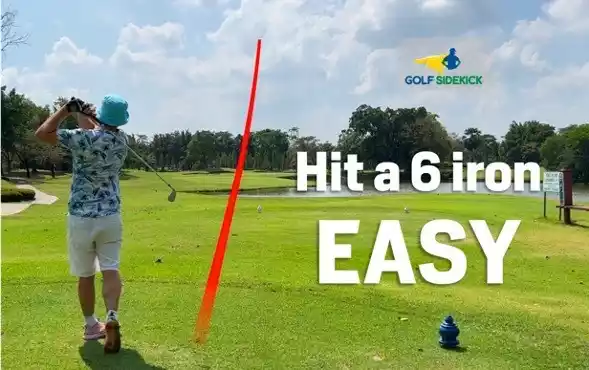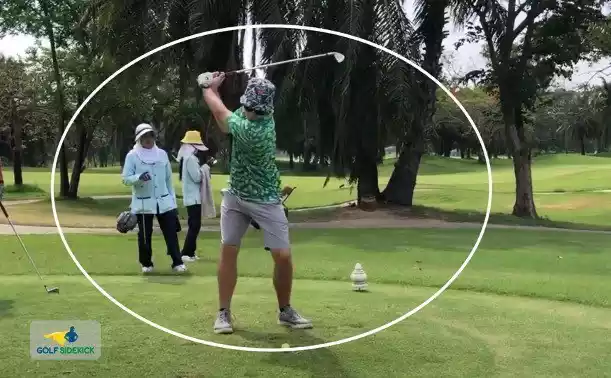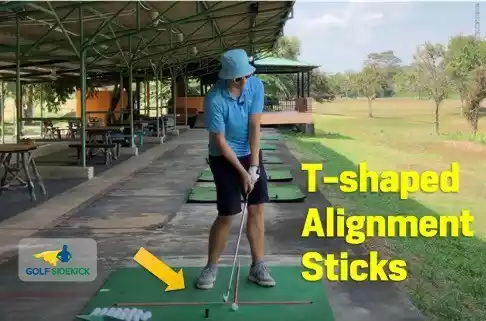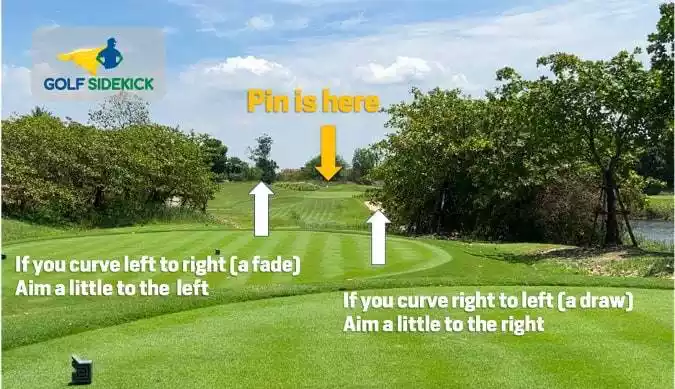Last Updated on January 30, 2024 by Matt Greene
The 6 iron feels so different to the 7 iron, doesn't it?
It presents only 4 degrees less loft than a 7 or 8 iron and somehow can make you feel like you need to help the ball into the air with a scoop.
But I have good news for you. You just hit the 6 iron like a 7 iron!
Don't know what that means? Fear not because I'll walk you through every aspect of the 6 iron from how to hit a 6 iron through to the loft, launch angle, and average distances plus much more.

The 6 core principles to hit a 6 iron better
- Pick a tiny target in the distance - aim small and you will miss small - but select a tree branch, something way above ground.
- Control your ball position - play the ball where the bottom of your swing is when you take a divot.
- Swing with trust in the club loft - the lower loft is intimidating, but pretend it's a 7 iron or 8 iron.
- Learn your ball flight - do you curve it left to right or right to left? Aim accordingly.
- Learn your carry yardage - how far do you truly fly the ball? Don't lie to yourself, be honest about your distance.
- Learn to hit your 6 iron at the beach - if you can hit the ball off the beach, you will forever hit 6 iron well.
How to hit a 6 iron better step by step
Principle #1 – Pick a small target to aim at. Really small.
This is a concept I picked up from pro golfer Michelle Low in Malaysia.
Your target must be as tiny as possible. The tip of the flag, the leaf on a tree or a window in a house in the distance.
You must not be able to reach the target you pick.
You hit to that impossible to reach target with a light heart because you know it's just a game.
What you don't realize and I hope you will learn, is that by focusing on some impossible to reach target but trying anyway, you eliminate all the trouble in front of you.
This narrow focus shuts out background noise and allows you to concentrate on the target.
If you are struggling with your 6 iron dispersion, try this and it will help unconsciously focus your mind. It means you're not thinking about golf swing positions and mechanics. Just pick a target, swing and allow the the golf ball to get in the way of your golf club.
Principle #2 – Learn the low point of your swing with ball position (hit 6 iron consistently)
Ball position is a really simple fix that is fundamental to every golf shot, from hitting the driver to chipping and putting.
My ball position slowly creeps back in my stance toward my back foot over time. I catch myself every few months and need to change my habit.
Most amateur golfers struggle to control where the low point of their swing is so they hit the ground before the ball a lot of the time. It's one of the biggest differences between high handicap and low handicap players and you can improve it easily.

Having a consistent ball position with your 6 iron gives you a more consistent strike point and encourages a better contact with the center of the club.
The most important thing when hitting your mid irons like your 6 iron is that your iron club head strikes the ball at the bottom of the arc.
In the picture above, the bottom of my arc with this 6 iron is inside my left heel. The camera angle is not 100% square but my ideal ball position is about 1-2 inches inside my left heel.
A ball position too far back creates a steep angle into the golf ball at impact and encourages a hook.
A ball position that is too far forward encourages a slice.
How do you find your correct ball position?
Go to a driving range, get a bucket but do not hit any balls yet. Get your 6 iron.
First start by hitting the ground with your normal swing. Don't try hit an imaginary ball.
Just swing your swing and try to clip the bottom of a daisy stem right out the ground. Notice and pay attention to where the club head is striking the turf in relation to your stance. You'll find that it strikes the ground in roughly the same spot over and over.
THIS is your correct bottom or low point of your golf swing with the 6 iron. Place the ball at the position at start of the divot and begin to hit balls again. by trying to nip the daisy stem out of the ground. I bet you'll start hitting the ball crisply. Remember the point is to get your club head to swing, while the ball gets in the way of your natural arc.
Drill that ball position

For the 6 iron (which is when you get into the long irons) I would broadly say that the ball needs to be slightly further forward in your stance so that you can get your weight forward. Again, this will mean different things to different players, but get to a driving range, and do the daisy cutting routine above.
But once you know where your low point is, you must DRILL it into your body and your mind and your eyes. Once you're settled on the ball position you want, use alignment sticks to make a cross or a T-shape to know that every time you take a stance, you are in the correct position.
Pro tip: Get a friend or playing partner to take a photo of your ball position from time to time to check where it is. Or get a tripod to film yourself.
Principle #3 – Swing with confidence - trust the loft
As the loft of the club face decreases, golfers do strange things to get the ball into the air. Some will put the ball by their front foot and then attempt to scoop the ball into the air using a very wristy swing. This actually creates a big slice!
This isn't a very natural movement and could cause you to injure yourself. The 6 iron loft is around 24 to 28 degrees. I promise that the club has enough loft to get the ball in the air. You don't need to help it.
I also see many high handicap golfers decelerate at the impact area. This isn't limited to the six iron, I have seen this happen throughout the bag. I believe that this is because golfers do not trust the loft of the club to get the ball into the air. They have probably also had bad experiences hitting the ball thin. A lot of golfers lack the confidence about their swing speed to trust they can hit the ball with enough power. This is mostly a fallacy.
All you need to make a committed swing with enough swing speed to get the ball airborne. It's just science. In years past, golf clubs were hard to hit but with modern technology and new features, getting the ball in the air has never been easier. You can swing it with enough speed to get a modern six iron in the air. The backspin on the shot and the loft of the club combined with the grooves on the face will elevate the ball.
How to make good contact with 6 iron
If you struggle to get your six iron in the air, go to the range and make some swings off a tee. You can tee it high to start. You can work the height of the tee down. Eventually, you want to be clipping the grass or taking a divot, hitting the ball before the ground.

Swing hard not fast
Now there is a BIG different between hitting the ball hard and swinging fast. Some would argue that you can never have a swing speed which is too fast, but if you've ever seen a player whiff a shot after swinging out of their shoes, I'd argue that you can swing too fast.
What players confuse is speed and tempo. Have you ever seen a top professional hit the ball up close. It looks effortless, but they will be generating some serious swing speed and club head and ball speeds. They are in control of their body and their swing and are able to hit the ball hard without making it look like they are.
Tiger Woods said "swing as hard as you can while guaranteeing a center strike on the clubface." I think too many golfers heard the "swing as hard as you can" bit and forgot about the perfect center strike part!
Principle #4 – Learn your ball flight
A lot of people will complain about their consistency yet hit the ball with a similar curve and height on every shot. The problem is that their RESULT is not consistent because they are not planning for their shot.
I don't care if you're a 2 or 20 handicapper - you must learn your shot shape tendencies with every club in your bag. As you get better at the game, these tendencies will become more uniform and predictable BUT, even high handicappers will have a specific shot shape with specific golf clubs.
Most players will begin the game with a bit of slice or fade shape and this is fine! I have seen many, many golfers complain about their slice and yet they hit the ball with a tighter dispersion than I do, they just don't aim for their shot shape. There is no shame in hitting a big fade to start with.

As you get into the longer irons, you will notice that the shot shape may change with these clubs. The loft and lie angle may promote a fade so you must mindfully take note of the shot shape you hit and aim for it.
A six iron may also fly a bit lower so account for that too. I will often use my six iron to punch the ball from under the trees, its a great way to get out of trouble. Mid handicappers can use their irons like this to get out of trouble to start breaking 90 more often. It is one of the most valuable shots.
Principle #5 – Learn your 6 iron distance and carry yardage - Course management
How far do you hit your 6 iron? 150 yards? 175 yards? Is that total distance or carry distance? It is really important that we differentiate between these two numbers, as many golfers think they hit the ball a greater distance than they really do. Carry distance is the number we want to focus on as it will allow us to navigate around the course and find the fairway and greens more consistently.
A 6 iron can be a potent weapon for the high handicapper if they know their carry distance. It is a great tee club as it will more than likely keep you away from trouble. You need to learn to hit a variety of shots with this club:
- Tee shots
- Fairway lay up shots
- Punch shots to get out of trouble
- Approach shots
The six iron can do all of these things. You could probably play a whole round with a six iron a pitching wedge and a putter and be absolutely fine.
Once you know your carry distances from a number of lies and positions, the six iron will be your key to success in getting better at golf.
Principle #6 – Learn to hit a 6 iron at the beach
This is a bonus concept on how to hit most of your irons crispy.
Take your 6 iron with you to the beach as well as 10 or 20 balls. Your job is to hit the golf balls down the beach with a center strike. If you hit it fat in the sand, you'll know about it. you'll adapt your swing to be able to start catching the ball before the sand.
This is easily the number one tip I would give to anyone wanting to pure their irons if they are hitting it chunky and inconsistent. I did it when I was 12 years old and 25 years later, it still serves me well on my iron shots. It's also a big reason why I like fairway bunkers so much.
Bonus tip - get a forgiving 6 iron and up
You can blend your iron set to make them easier to hit. You don't have to play the same model of golf iron in your whole bag. Most manufacturers make irons that are forgiving but also have even more forgiving models in their range. You can buy individual irons from them to make your 5 and 6 iron easier to hit - for example the Srixon range has ZX7 which are easy players irons, ZX5 which are even easier to hit and the ZX4 range which are the easiest. You can mix and match.
And if you find it's too hard to hit a standard 6 iron, you can always use a 6 hybrid! The golf club manufacturers make hybrids in all sorts of lofts. It's a good alternative.
Extras: Course strategy guides and how to articles
I have written a number of guides to help you break you scoring barriers on the golf course and become the golfer you know you can be. The most important are breaking 100, breaking 90 and breaking 80.
